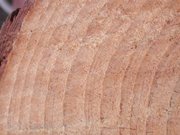Growth ring
|
|

Pine_tree_rings.JPG
Growth rings (or "annular rings") can be seen in a horizontal cross section cut through the trunk of a tree. Visible rings result from the change in growth speed through the seasons of the year, thus one ring usually marks the passage of one year in the life of the tree. The rings are more visible in temperate zones, where the seasons differ more markedly.
The inner portion of a growth ring ring is formed early in the season, when growth is comparatively rapid (hence the wood is less dense) and is known as "early wood" or "spring wood"; the outer portion is the "late wood" or "summer wood," being produced in the summer, and is more dense. However, in trees like white pines there is not much contrast in the different parts of the ring, and as a result the wood is very uniform in texture and can be said to have a mild grain, visually.
Adequate moisture and a long growing season results in a wide ring. A drought year may result in a very narrow one. Trees from the same region will tend to develop the same patterns of width for a given period. For the entire period of a tree's life, a year-by-year record or ring pattern is formed that in some way reflects the climatic conditions in which the tree grew.
Growth rings are the basis for the historical dating science of dendrochronology.
Growth rings are responsible for the grain and knots visible in wood.ja:年輪 he:טבעות עץ
